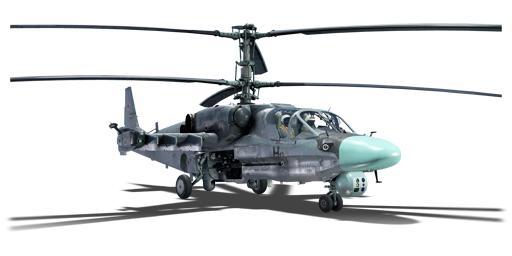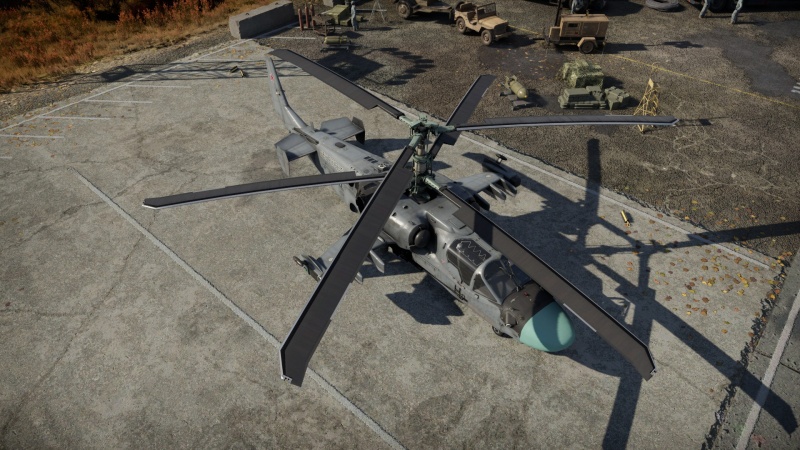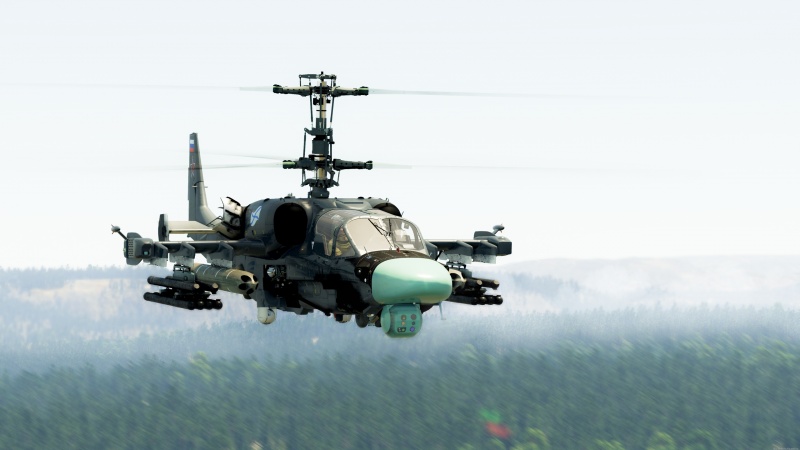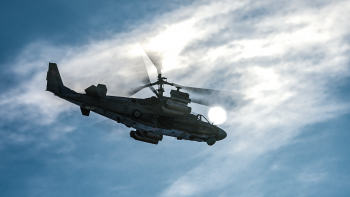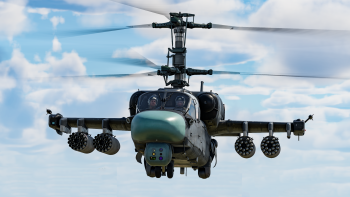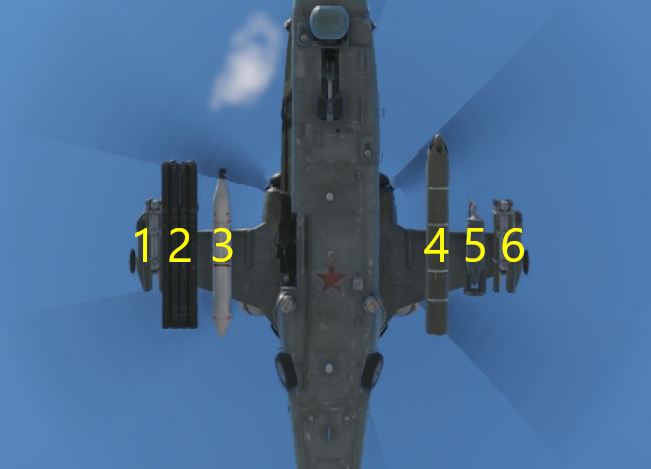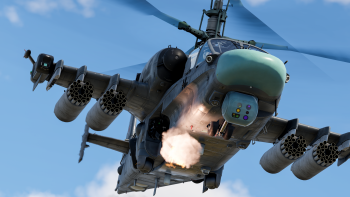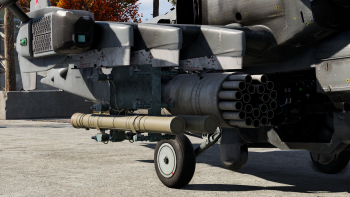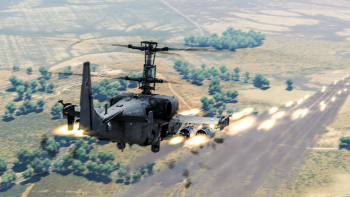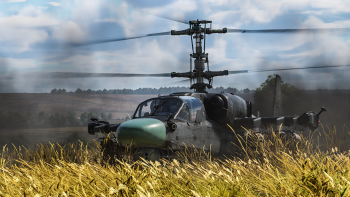Difference between revisions of "Ka-52"
CobraKingII (talk | contribs) (→History) (Tag: Visual edit) |
Colok76286 (talk | contribs) |
||
| (49 intermediate revisions by 21 users not shown) | |||
| Line 1: | Line 1: | ||
| − | {{Specs-Card|code=ka_52}} | + | {{Specs-Card |
| + | |code=ka_52 | ||
| + | |images={{Specs-Card-Image|GarageImage_{{PAGENAME}}.jpg|Ka-52 WebsiteImage 1.jpg}} | ||
| + | }} | ||
== Description == | == Description == | ||
<!-- ''In the description, the first part should be about the history of and the creation and combat usage of the helicopter, as well as its key features. In the second part, tell the reader about the helicopter in the game. Insert a screenshot of the vehicle, so that if the novice player does not remember the vehicle by name, he will immediately understand what kind of vehicle the article is talking about.'' --> | <!-- ''In the description, the first part should be about the history of and the creation and combat usage of the helicopter, as well as its key features. In the second part, tell the reader about the helicopter in the game. Insert a screenshot of the vehicle, so that if the novice player does not remember the vehicle by name, he will immediately understand what kind of vehicle the article is talking about.'' --> | ||
| − | + | In the early 1980s, while the Ka-50 was facing off against the Mi-28 in state acceptance trials, the Kamov design team came up with a special variant of their helicopter: A dedicated "battlefield support" with more weapon hardpoints than the Ka-50, far more advanced optics and sensors, and an air-to-ground radar for surveying the battlefield. This new helicopter had so many different systems to operate, that it required a second crew member, therefore a tandem "side-by-side" cockpit was chosen for multiple reasons, one of which was to differentiate it from the Mi-24 and Mi-28 cockpit designs where the pilot sat behind the gunner. The finalized design of the new aircraft, now named the Ka-52, would receive two more wing-mounted hardpoints than its Ka-50 predecessor, in addition to a dedicated multimode A2G radar, and a day/night thermal sight (both of which the Ka-50 lacked). To keep flight performance on par with the Ka-50, the cockpit armour and amount of ammo in the cannon was greatly reduced, and a new VK-2500 engine was developed for this helicopter. The first phase of trial testing was completed in 2008, and serial production of the Ka-52 was officially greenlit from that point as it entered service with the Russian VVS. | |
| − | + | ||
| − | The '''{{Specs|name}}''' | + | The '''{{Specs|name}} "Alligator"''' (NATO reporting name: ''Hokum-B''), introduced in [[Update 1.97 "Viking Fury"]], has similar weapons to the Ka-50, including the infamous [[9K127 Vikhr]] ATGMs with excellent range and proximity fuses, and superior electronics with little impact on the great flight performance. The Alligator is a well-rounded attack helicopter that can seek and destroy ground targets and still pose a considerable threat to aircraft. The Ka-52 is also armed with a powerful 2A42 cannon with strong APDS belts, and the unguided SO-13OF rockets which can almost always destroy a tank in a single hit due to their massive HE payload. All in all, the Ka-52 is one of the best helicopters in all of War Thunder, and acts as a great reward at the end of the line for players who were patient enough to research their way up to it. |
== General info == | == General info == | ||
=== Flight performance === | === Flight performance === | ||
| − | <!--''Describe how the helicopter behaves in the air. Speed, manoeuvrability, acceleration and allowable loads - these are the most important characteristics of the vehicle.''--> | + | [[File:Ka-52 3.png|thumb|350px|Ka-52 in flight]] |
| + | {{Specs-Heli-Flight}} | ||
| + | <!-- ''Describe how the helicopter behaves in the air. Speed, manoeuvrability, acceleration and allowable loads - these are the most important characteristics of the vehicle.'' --> | ||
{| class="wikitable" style="text-align:center" | {| class="wikitable" style="text-align:center" | ||
|- | |- | ||
| − | ! | + | ! rowspan="2" | Characteristics |
| − | |||
| − | |||
| − | |||
! colspan="2" | Max Speed<br>(km/h at 1,000 m) | ! colspan="2" | Max Speed<br>(km/h at 1,000 m) | ||
! rowspan="2" | Max altitude<br>(metres) | ! rowspan="2" | Max altitude<br>(metres) | ||
| Line 22: | Line 24: | ||
! AB !! RB | ! AB !! RB | ||
|- | |- | ||
| − | |315||289|| | + | ! Stock |
| + | | 315 || 289 || rowspan="2" | {{Specs|ceiling}} | ||
|- | |- | ||
| − | ! | + | ! Upgraded |
| − | + | | 320 || 310 | |
| − | |||
| − | |||
| − | |||
| − | |||
| − | |||
| − | |320||310 | ||
|- | |- | ||
|} | |} | ||
=== Survivability and armour === | === Survivability and armour === | ||
| − | <!--''Examine the survivability of the helicopter. Note how vulnerable the structure is and how secure the pilot is, whether the fuel tanks are armoured, etc. Describe the armour, if there is any, and also mention the vulnerability of other critical systems.''--> | + | {{Specs-Heli-Armour}} |
| + | <!-- ''Examine the survivability of the helicopter. Note how vulnerable the structure is and how secure the pilot is, whether the fuel tanks are armoured, etc. Describe the armour, if there is any, and also mention the vulnerability of other critical systems.'' --> | ||
| + | |||
| + | * 44 mm Bulletproof glass - front windscreen of the helicopter | ||
| + | * 20 mm Aluminium alloy - Sides of the cockpit | ||
| + | * 20 mm Aluminium alloy - Bottom of the self-sealing fuel tanks | ||
| − | + | The helicopter has four separate fuel tanks: three at the rear of the fuselage, and one just behind the cockpit. Engines are placed above the autocannon with the fuel tanks spaced out around it. | |
| − | |||
| − | |||
| − | + | === Modifications and economy === | |
| + | {{Specs-Economy}} | ||
== Armaments == | == Armaments == | ||
| + | {{Specs-Heli-Armaments}} | ||
| + | {| class="wikitable" style="text-align:center" | ||
| + | |- | ||
| + | ! colspan="3" | [[Ballistic Computer]] | ||
| + | |- | ||
| + | ! CCIP (Guns) !! CCIP (Rockets) !! CCIP (Bombs) | ||
| + | |- | ||
| + | | {{Tick}} || {{Tick}} || {{Tick}} | ||
| + | |- | ||
| + | |} | ||
=== Offensive armament === | === Offensive armament === | ||
| − | <!--Describe the offensive armament of the | + | {{Specs-Heli-Offensive}} |
| + | <!-- ''Describe the offensive armament of the helicopter, if any. Describe how effective the cannons and machine guns are in battle, also what ammunition belts or drums are better to use. If there is no offensive weaponry, delete this subsection.'' --> | ||
| + | [[File:Ka-52 Armament.png|thumb|350px|Ka-52 armed with S-8KO unguided rockets]] | ||
{{main|2A42 (30 mm)}} | {{main|2A42 (30 mm)}} | ||
The '''''{{PAGENAME}}''''' is armed with: | The '''''{{PAGENAME}}''''' is armed with: | ||
| − | * 1 x 30 mm 2A42 cannon, right fuselage-mounted (460 | + | * A choice between two presets: |
| + | ** 1 x 30 mm 2A42 cannon, right fuselage-mounted (460 rpg) | ||
| + | ** 1 x 30 mm 2A42 cannon + 128 x countermeasures | ||
| + | |||
| + | The 30 mm 2A42 cannon can be equipped with a mixed (default) belt, an air targets belt, or a ground targets belt. | ||
| − | + | * '''Default:''' {{Annotation|AP-T|Armour-piercing tracer}}{{-}}{{Annotation|HEF-I*|High-explosive fragmentation incendiary (self-destroying)}}; max penetration: 63 mm at 100 metres | |
| + | * '''Ground targets:''' {{Annotation|APDS|Armour-piercing discarding sabot}}{{-}}{{Annotation|AP-T|Armour-piercing tracer}}{{-}}{{Annotation|HEF-I*|High-explosive fragmentation incendiary (self-destroying)}}{{-}}{{Annotation|HEF-I*|High-explosive fragmentation incendiary (self-destroying)}}; max penetration: 81 mm at 100 metres | ||
| + | * '''Air targets:''' {{Annotation|HEF-T*|High-explosive fragmentation tracer (self-destroying)}}{{-}}{{Annotation|AP-T|Armour-piercing tracer}}{{-}}{{Annotation|HEF-I*|High-explosive fragmentation incendiary (self-destroying)}}{{-}}{{Annotation|HEF-I*|High-explosive fragmentation incendiary (self-destroying)}}; max penetration: 63 mm at 100 metres | ||
| + | * '''Armoured targets:''' {{Annotation|APDS|Armour-piercing discarding sabot}}; max penetration: 81 mm at 100 metres | ||
| − | + | The 2A42 autocannon returns from the previous Ka-29, this time mounted on the right side of the cockpit. The mount has very little horizontal traverse, so the Ka-52 must point its nose near any target it is trying to shoot. The auto-tracker is very helpful for aiming the cannon; if the target is beyond the cannon traverse limits, the cannon will hold fire, and once lined up properly the system will take care of the necessary lead. With APDS rounds, it can be a real menace to light targets from any approach angle. | |
| − | |||
| − | |||
=== Suspended armament === | === Suspended armament === | ||
| − | <!--''Describe the | + | {{Specs-Heli-Suspended}} |
| − | + | <!-- ''Describe the helicopter's suspended armament: additional cannons under the winglets, any bombs, and rockets. Since any helicopter is essentially only a platform for suspended weaponry, this section is significant and deserves your special attention. If there is no suspended weaponry remove this subsection.'' --> | |
| − | |||
The '''''{{PAGENAME}}''''' can be outfitted with the following ordnance: | The '''''{{PAGENAME}}''''' can be outfitted with the following ordnance: | ||
| − | + | {| class="wikitable" style="text-align:center" width="100%" | |
| − | + | |- | |
| − | + | ! !! width="7%" | 1 !! width="7%" | 2 !! width="7%" | 3 !! width="7%" | 4 !! width="7%" | 5 !! width="7%" | 6 | |
| − | + | | rowspan="10" width="30%" | <div class="ttx-image">[[File:Hardpoints_{{PAGENAME}}.png]]</div> | |
| − | + | |- | |
| − | + | ! [[GSh-23L (23 mm)|23 mm GSh-23L]] cannons (250 rpg) | |
| − | + | | || 1 || 1 || 1 || 1 || | |
| − | + | |- | |
| − | + | ! [[OFAB-250sv (250 kg)|250 kg OFAB-250sv]] bombs | |
| − | + | | || 1 || 1 || 1 || 1 || | |
| − | + | |- | |
| − | + | ! [[FAB-500M-62 (500 kg)|500 kg FAB-500M-62]] bombs | |
| − | * | + | | || || 1 || 1 || || |
| − | * | + | |- |
| − | * | + | ! [[S-8KO]] rockets |
| − | *4 x | + | | || 20 || 20 || 20 || 20 || |
| − | *12 x | + | |- |
| − | *12 x | + | ! [[S-13OF]] rockets |
| − | + | | || 5 || 5 || 5 || 5 || | |
| − | *4 x | + | |- |
| − | * | + | ! [[9K127 Vikhr]] missiles |
| − | * | + | | || 6 || || || 6 || |
| − | + | |- | |
| − | + | ! [[9M39 Igla]] missiles | |
| + | | 4 || || || || || 4 | ||
| + | |- | ||
| + | ! [[9M120-1 Ataka]] missiles | ||
| + | | || 2, 6 || || || 2, 6 || | ||
| + | |- | ||
| + | | colspan="7" | Maximum permissible weight imbalance: 480 kg | ||
| + | |- | ||
| + | |} | ||
| + | |||
| + | {{Navigation-Start|Default weapon presets}} | ||
| + | {{Navigation-First-Simple-Line}} | ||
| + | * Without load | ||
| + | * 8 x 9M39 Igla missiles | ||
| + | * 80 x S-8KO rockets | ||
| + | * 20 x S-13OF rockets | ||
| + | * 4 x 9M120-1 Ataka missiles | ||
| + | * 12 x 9K127 Vikhr missiles | ||
| + | * 12 x 9M120-1 Ataka missiles | ||
| + | * 4 x 250 kg OFAB-250sv bombs (1,000 kg total) | ||
| + | * 2 x 500 kg FAB-500M-62 bombs (1,000 kg total) | ||
| + | * 4 x 23 mm GSh-23L cannons (250 rpg = 1,000 total) | ||
| + | {{Navigation-End}} | ||
| − | + | The Ka-52 has an impressive arsenal. It has access to two types of ATGMs: the 9K127 Vikhr with laser-beam riding guidance, and the 9M120-1 Ataka. The Vikhr should be the go-to choice: it has an excellent 10 km launch range that matches or exceeds many SAM systems, a best-in-class 610 m/s flight speed, and a proximity fuse that is effective against aircraft and even incoming missiles. This combination of anti-ground, anti-air, and active defense capabilities is a lot of utility in one missile. The only real downside is the underwhelming raw penetration of 800 mm, which can be absorbed by the frontal turret armour of many top-tier MBTs, so it is important to aim for hull armour when possible. The laser-beam guidance also requires that the Ka-52 maintain a constant line of sight to its target. As for the Ataka, it is significantly inferior to the Vikhr in range and lacks a proximity fuse, making it a straight downgrade that should only be used when stock grinding. | |
| − | + | ||
| − | + | In addition to the S-8KO HEAT rockets familiar to Soviet helicopter pilots, the Ka-52 has larger calibre S-13OF rockets with HE warheads that can knock out MBTs with direct hits. Both are good options for rocket rushes. | |
| − | + | Pilots who miss using the Mi-24 Hinds as bombers can have fun with the 250 kg and 500 kg bombs (which the later Mil Mi helicopters can no longer carry), but they are more novelties than practical options at top-tier battles given the abundance of advanced anti-air capabilities. | |
| − | |||
| − | |||
| − | + | A notable upgrade of the Ka-52 compared to the original Ka-50 is that it has dedicated wingtip hardpoints for the 9M39 Igla air-to-air missiles. The Iglas are all-aspect infrared MANPADS with ECCM and up to 8 can be carried, which is an impressive quantity. Unfortunately they have only 10 G of overload and are easily dodged by any aircraft that is paying attention, not even needing flares. The weak warhead with only 530 g of TNT equivalent will sometimes fail to cause critical damage even upon a successful hit. The Vikhr ATGMs are typically more effective at swatting other helicopters and low-flying aircraft, but it does not hurt to have some Iglas on hand as fire-and-forget weapons to sling at distracted CAS jets cruising at medium altitudes. | |
| − | |||
| − | |||
| − | + | Lastly, the ever-present GSh-23L gunpod is available, but it has little utility on the Ka-52 given that it is far weaker than the internal autocannon and cannot be guided by the auto-tracker. | |
| − | + | === Defensive systems === | |
| + | <!--''Defensive armament with turret machine guns or cannons, crewed by gunners. Examine the number of gunners and what belts or drums are better to use. If defensive weaponry is not available, remove this subsection.''--> | ||
| + | The Ka-52 can be outfitted with HIRSS (Hover Infrared Suppressor Subsystem), MAW (Missile Approach Warning) system, and 128 countermeasures. | ||
| − | + | * 128 countermeasures are installed on the wingtips in two pods. | |
| − | + | * HIRSS is a shield mounted on the exhaust that dissipates heat escaping from the exhaust, reducing the possibility of a successful enemy lock-on with a heat-seeking missile. | |
| + | * The Missile Approach Warning (MAW) detects any incoming missile and notifies you about it, as well deploying the countermeasures automatically. | ||
| + | * The helicopter is equipped with a laser-based DIRCM (Directional Infrared Countermeasures) system, which shines laser beam at incoming infrared homing missiles to effectively disrupt their tracking. This system is much more reliable and effective than other IRCM system in-game. | ||
| − | + | == Usage in battles == | |
| + | <!-- ''Describe the tactics of playing in a helicopter, the features of using the helicopter in a team and advice on tactics. Refrain from creating a "guide" - do not impose a single point of view, but instead, give the reader food for thought. Examine the most dangerous enemies and give recommendations on fighting them. If necessary, note the specifics of the game in different modes (AB, RB, SB).'' --> | ||
| − | + | The Ka-52 is a true gladiator of the sky. It excels in any type of combat scenario, mainly air-to-ground operations. It can be equipped with a wide selection of armaments. From rockets and bombs to missiles, it has 24 different armament loadouts. Its two almighty Klimov TV3-117VMA turboshaft engines provide 2,350 BHP and 2,100 kgf of thrust each, making this 10,400 kg beast dance in the sky, like a ballerina dancing on a cloud. The Ka-52 has a total of six wing hard points, with three hard points on each wing. | |
| − | + | === Air to Air === | |
| + | ==== Ka-52 vs. Helicopters ==== | ||
| − | + | The Ka-52 in helicopter engagements requires some tactics and understanding of the other enemy helicopters that will be encountered in battle. | |
| − | + | '''Using the 30 mm autocannon''' | |
| − | + | The Ka-52 is equipped with its [[2A42 (30_mm)|30 mm 2A42]] autocannon, the same cannon installed on the [[Ka-50]] and [[BMP-2]], able to destroy pillboxes, tanks, helicopters and jets with ease. | |
| + | [[File:Ka-52 2A42.png|thumb|350px|Ka-52 firing the 30 mm 2A42 autocannon]] | ||
| + | It's important to keep your speed high, which in turn which increase your agility. The Ka-52 can achieve this easily by just pointing the noise of the helicopter towards the enemy units. However, make sure to adjust for the location of the autocannon, as it is not mounted below or on the wings, but instead on the right side of the fuselage. The 2A42 only has a limited traverse of 30 degrees instead of full traverse as seen on the [[Mi-28 (Family)]] helicopters. | ||
| − | + | Since the Ka-52 only has 460 rounds of ammunition, it is important to always aim for critical elements of the enemy helicopter which are: | |
| − | |||
| − | |||
| − | * | + | * The engine(s) |
| + | * The transmission | ||
| + | * The tail | ||
| + | This is important because it allows ammunition to be conserved. | ||
| − | '''Using the ATGM & air-to-air missiles to | + | '''Using the ATGM & air-to-air missiles to destroy enemy helicopters''' |
| − | + | Before unlocking the iconic, lethal & legendary [[9K127 Vikhr|9K121 Vikhr]] missiles, which have made the [[Ka-50]] a prominent & terrifying experience to be fighting against, [[9M120-1 Ataka]] missiles are to used before. These are the same missiles used on the [[Mi-35M]] and Mi-28 helicopters, and they offer up to 950 mm of penetration. | |
| − | To | + | To achieve the best chance of scoring a hit, it is important to position the Ka-52 well. Keep enough space in the gunner's field of view rectangle for any adjustments that may have to be made. Unlike the Ka-50, the Ka-52 has a smaller rectangle which makes tracking a target more difficult if it is moving. This will require the Ka-52 to be adjusted in flight, which can cause the missile to overshoot or miss due to corrective actions. |
| − | + | '''Using the Ataka missiles''' | |
| − | '''Using the | ||
| − | The | + | The [[9M120-1 Ataka]] missiles travel at 550 m/s; they are not as fast nor do they have a proximity fuse as seen on the Vikhr missiles. The Atakas require a direct hit on the enemy; it is best to manoeuvre the Ka-52 into a position where the enemy helicopter is fully exposed and as close as possible, around 5 to 8 km. Make sure the missile is in the middle of the gunner's field of view rectangle for the tracking to follow it when it has been fired. |
| + | [[File:Ka-52 Atakas.png|thumb|350px|Ka-52 armed with Ataka missiles and S-8KO unguided rockets]] | ||
| + | A main challenge of using the Atakas is that if the helicopter has been engaged head-on at distance, the enemy player only has to dodge it, unlike the Vikhrs which feature a proximity fuse. This exposes your position and allows the enemy to fire back at you, possibly knocking you out of the match. | ||
| − | + | '''Using the Vikhr missiles''' | |
| + | The lethal [[9K127 Vikhr|9K121 Vikhr]] missiles only needs to be in close proximity of an enemy helicopter or aircraft to destroy it. When using the Vikhrs, it is possible to lock an enemy and manually guide the missile, adjusting it for any correction or evasion tactics which are in play, to hit the target. More often, automatically locking the target with the Vikhr missile will suffice. | ||
| − | + | Unlike the Atakas, the Vikhrs are able to knock out enemy helicopters and jets from the front even if they try to evade, as long as it is close to them. It will explode, either destroying them or scoring a critical hit. | |
| − | + | '''Using the Igla missiles''' | |
| − | + | The Ka-52 carries up to four [[9M39 Igla]] missiles on top of its 12 Ataka or Vikhr loadouts. Each Igla is able to destroy an enemy helicopter with ease. With a top speed of Mach 1.7 and a max range of 5 km, with ECCM, the Iglas are a deadly weapon. It is able to down any enemy helicopter encountered. However, if the enemy is equipped with MAW or spots the missile and deploys flares, it could miss. The best position to launch an Igla is when they have either exposed their broadside or their rear. It is possible to fire it head-on, but if they deploy flares, it will reduce the chances of a missile hit. | |
| + | ==== Ka-52 vs. Fighters ==== | ||
| − | + | A Ka-52 can be equipped with up to eight Iglas. Whether the enemies fly fixed-wing aircraft or rotary-wing aircraft, the Igla will be effective. The ideal firing position for fixed-wing aircraft is to have the enemy aircraft approaching you head-on. This allows the Ka-52 to quickly lock the target and fire the missile; once fired it is possible to see that aircraft on fire, spiraling down towards the ground. | |
| − | + | If the enemy has fired, the enemy missile can be evaded easily thanks to the MAW systems and IRCM on-board the helicopter, but you must also descend rapidly to the deck in an effort to stress the missile's pull. Once you have evaded the missile, lock on to the enemy aircraft and fire. In the event that the enemy aircraft evades the missile, they will most likely come back around and engage you again, so employ the same tactics as before. Remember, you have up to eight Iglas at the ready. | |
| − | === | + | ===Air to Ground=== |
| − | + | ====Ka-52 vs. SPAA==== | |
| − | + | '''Engaging at long range:''' | |
| − | + | The first target which should be always prioritised and knocked out is the enemy SPAA. Switch to thermals if unlocked and profile the battlefield for any SPAA. When located, fire one of your ATGMs and glide it on target until it hits and destroys it. | |
| − | + | '''Defeating and evading an enemy missile:''' | |
| − | + | In the event that an enemy SPAA has spotted and fired on you, deploy flares and drop to low altitude. Fly just under 20 m above the ground; the enemy missile's proximity fuse will not activate at this altitude. | |
| − | |||
| − | + | '''Engaging at close range:''' | |
| − | |||
| − | + | [[File:Ka-52 Rockets.png|thumb||350px|Ka-52 firing S-8KO unguided rockets]] | |
| − | Using the autocannon, a few | + | Using the autocannon, a few shots in the turret of an SPAA will destroy it. Using the rockets from the rocket pods, a well-placed shot will knock it out. |
| − | Using the rockets from the rocket pods, a | ||
| − | ====Ka-52 | + | ====Ka-52 vs. Tanks==== |
| − | + | When engaging tanks from the front, it is best to fire two ATGMs to knock it out, as the ERA plates and armour will reduce the explosive energy of your missiles. However, if the enemy tank is being engaged from the side, a single well-placed shot just in front of the engine and behind the turret will see it exploding like a magical firework on the legendary St. Petersburg victory day celebration. | |
| − | Additionally the autocannon | + | Additionally, the autocannon is able to destroy the enemy tanks too! The best way to do this is to approach from the rear, line up with the engine deck of the tank, and set it on fire, that will stop them in their tracks. However, do not leave them there or stop firing just yet. Keep firing and fly around them in a circle while aiming for the roof of the turret, the rounds will be able to penetrate them and knock out their crew. |
| − | |||
| − | |||
| − | |||
| − | |||
| − | |||
| − | |||
| − | |||
| − | |||
| − | |||
| − | |||
| − | |||
| − | |||
| − | |||
| − | |||
| − | |||
| − | |||
| − | |||
| − | |||
| − | |||
| − | |||
| − | |||
| − | |||
| − | |||
| − | |||
| − | |||
| − | |||
| − | |||
| − | |||
| − | |||
| − | |||
| − | |||
| − | |||
| − | |||
| − | |||
| − | |||
| − | |||
| − | |||
| − | |||
| − | |||
| − | |||
=== Pros and cons === | === Pros and cons === | ||
| − | <!--Summarise and briefly evaluate the vehicle in terms of its characteristics and combat effectiveness. Mark its pros and cons in the bulleted list. Try not to use more than 6 points for each of the characteristics. Avoid using categorical definitions such as "bad", "good" and the like - use substitutions with softer forms such as "inadequate" and "effective".--> | + | <!-- ''Summarise and briefly evaluate the vehicle in terms of its characteristics and combat effectiveness. Mark its pros and cons in the bulleted list. Try not to use more than 6 points for each of the characteristics. Avoid using categorical definitions such as "bad", "good" and the like - use substitutions with softer forms such as "inadequate" and "effective".'' --> |
| − | + | [[File:Ka-52 Landing.png|thumb|350px|Ka-52 on the grass]] | |
'''Pros:''' | '''Pros:''' | ||
| − | * | + | * Very fast |
| − | * Good level of armour protection around the flight deck | + | * Agile and responsive despite the size |
| − | * | + | * Good level of armour protection around the flight deck |
| − | * | + | * Low thermal signature |
| − | * Six hard points | + | * Access to RWR, MAWS, and plentiful flare/chaff countermeasures |
| − | * | + | * Unique DIRCM system making it almost immune to IR missiles |
| − | * 30 mm | + | * Six hard points with flexible loadout options |
| + | * Effective anti-tank capabilities with the Vikhr missiles | ||
| + | * Features the 30 mm 2A42 autocannon with an AP belt that can penetrate up to 82 mm of armour, it can go through the roofs of most vehicles | ||
| + | * Excellent optics with thermal sights and high-power magnification for easy targeting | ||
| + | * Access to search radars and ballistic computers for all weaponry | ||
| + | * Highly versatile: a true multirole helicopter | ||
'''Cons:''' | '''Cons:''' | ||
| − | * Small area for locking on with | + | * Small area for locking on with Igla air-to-air missiles |
| − | * Small area for the gunner field of view | + | * Small area for the gunner field of view |
| − | * | + | * Autocannon is mounted on the right-hand side of the helicopter, limiting the firing arcs |
| − | * | + | * High angles of attack can result in fuel starvation to the engine |
== History == | == History == | ||
| Line 246: | Line 255: | ||
'''Development''' | '''Development''' | ||
| − | While the V-80 prototype (which would later become the Ka-50 "Black Shark") and Mi-28 attack helicopters were going through comparative tests, an idea for a dedicated battlefield reconnaissance and target designation helicopter was raised by the Kamov design team. Because of the Soviet economic downturn of the | + | While the V-80 prototype (which would later become the Ka-50 "Black Shark") and Mi-28 attack helicopters were going through comparative tests, an idea for a dedicated battlefield reconnaissance and target designation helicopter was raised by the Kamov design team. Because of the Soviet economic downturn of the 1980s, it was decided to base the new helicopter on the Ka-50 attack helicopter. The new reconnaissance and target designation equipment required the addition of a second crew member, who would operate the new systems. A side-by-side seating arrangement was chosen in order to facilitate co-operation of the two crew members. This new helicopter was designated as the Ka-52 and it was given the nickname "Alligator". |
'''Design''' | '''Design''' | ||
| − | The Ka-52 features | + | The Ka-52 features a radar dish in the nose, used for both ground and aerial targets. It also features a much more capable sight module in a spherical turret below the nose, with wider ranges of movement, both horizontally and vertically. The Ka-52 features the same side-mounted 2A42 30 mm autocannon as on the Ka-50; being limited in its rotation, it still packs a punch and is useful vs air and ground targets alike. It has six wing hardpoints (three on either wing), two more than the Ka-50, allowing for the usage of Igla AAMs without sacrificing rockets, bombs, or ATGMs. |
'''Production and Testing''' | '''Production and Testing''' | ||
| − | Construction of the first Ka-52 airframe began in 1996. Phase 1 of the testing was completed in December 2008, and phase 2 was authorized soon after. By the end of 2008, serial production had begun at the Progress Arsenyev Aviation Company plant | + | Construction of the first Ka-52 airframe began in 1996. Phase 1 of the testing was completed in December 2008, and phase 2 was authorized soon after. By the end of 2008, serial production had begun at the Progress Arsenyev Aviation Company plant in Arsenyev, Primorsky Krai. In 2010, eight Ka-52 helicopters were operated by the 696th Instructor and Research Helicopter Regiment, based at Torzhok Air Base. The eight helicopters were in varying states of capability and were used for testing purposes. Four more Ka-52 helicopters were delivered to the 44th Centre for Combat Training and Aircrew Conversion in December of 2010. |
| − | The Ka-52 entered service in May 2011 after completing all of the state trials; the first operational units received their Ka-52s in the same month. The first production contract was for 2 experimental Ka-52s and 24 serial Ka-52s by 2012. In 2011 the second contract was signed, worth 120 million rubles, for 146 Ka-52 helicopters by 2020. In February 2018, the Russian Defense Ministry expressed its desire to purchase 114 new Ka-52s for the State Armament Program for 2018–2027. | + | The Ka-52 entered service in May 2011 after completing all of the state trials; the first operational units received their Ka-52s in the same month. The first production contract was for 2 experimental Ka-52s and 24 serial Ka-52s by 2012. In 2011 the second contract was signed, worth 120 million rubles, for 146 Ka-52 helicopters by 2020. In February 2018, the Russian Defense Ministry expressed its desire to purchase 114 new Ka-52s for the State Armament Program for the years 2018–2027. |
'''Service''' | '''Service''' | ||
| − | The | + | The first major operational usage of the Ka-52 ''Alligator'' was during the Russian military intervention in the Syrian Civil War (2015). They were claimed to be used in the defense of the Russian base in Latakia. They were also used to escort search and rescue helicopters and to support Russian special forces. They were spotted for the first time near the town of Al-Qaryatayn, which had been recaptured from ISIS in April 2016. They were also used in the 2017 Palmyra offensive. Ka-52s took part in a Syrian paratrooper reconnaissance-strike mission on 12 August 2017. |
According to some sources, a Ka-52 crashed near Mayadin due to a technical failure on 5 May 2018. | According to some sources, a Ka-52 crashed near Mayadin due to a technical failure on 5 May 2018. | ||
== Media == | == Media == | ||
| − | <!--Excellent additions to the article would be video guides, screenshots from the game, and photos.--> | + | <!-- ''Excellent additions to the article would be video guides, screenshots from the game, and photos.'' --> |
| − | {{Youtube-gallery|_mhSXtNN9Ko|'''The Shooting Range #200''' - ''Metal Beasts'' section at 01:04 discusses the Ka-52.}} | + | |
| + | ;Skins | ||
| + | |||
| + | * [https://live.warthunder.com/feed/camouflages/?vehicle=ka_52 Skins and camouflages for the {{PAGENAME}} from live.warthunder.com.] | ||
| + | |||
| + | ;Videos | ||
| + | {{Youtube-gallery|M9zfP6ndAUA|'''KA-52 - Above All Else''' - ''JustinPlaysYT''|_mhSXtNN9Ko|'''The Shooting Range #200''' - ''Metal Beasts'' section at 01:04 discusses the Ka-52.}} | ||
== See also == | == See also == | ||
| − | ''Links to the articles on the War Thunder Wiki that you think will be useful for the reader, for example:'' | + | <!-- ''Links to the articles on the War Thunder Wiki that you think will be useful for the reader, for example:'' |
| + | * ''reference to the series of the helicopter;'' | ||
| + | * ''links to approximate analogues of other nations and research trees.'' --> | ||
| + | |||
| + | ;Rotorcraft of comparable role, configuration and era | ||
| − | * | + | * [[AH-64D]] |
| − | * | + | * [[EC-665 Tiger UHT]] |
| + | * [[Ka-50]] | ||
| + | * [[AH Mk.1]] | ||
| + | * [[EC-665 Tiger HAD]] | ||
== External links == | == External links == | ||
| − | ''Paste links to sources and external resources, such as:'' | + | <!-- ''Paste links to sources and external resources, such as:'' |
| + | * ''topic on the official game forum;'' | ||
| + | * ''other literature.'' --> | ||
| − | * | + | * [[wikipedia:Kamov_Ka-50#Ka-52_%22Alligator%22|[Wikipedia] Ka-52 "Alligator"]] |
| − | * | + | * [https://www.airforce-technology.com/projects/ka52-alligator-attack-helicopter-russia/ <nowiki>[Air Force Technology]</nowiki> Ka-52 Alligator Attack Helicopter] |
| − | * | + | * [https://www.naval-technology.com/projects/kamovka52alligatorhe/ <nowiki>[Naval Technology]</nowiki> Kamov Ka-52 Alligator Helicopter] |
| + | * [http://www.military-today.com/helicopters/ka52_hokum_b.htm <nowiki>[Military-Today]</nowiki> Kamov Ka-52] | ||
| + | * [https://www.militaryfactory.com/aircraft/detail.asp?aircraft_id=1333 <nowiki>[MilitaryFactory]</nowiki> Kamov Ka-52 Alligator (Hokum-B)] | ||
{{AirManufacturer Kamov}} | {{AirManufacturer Kamov}} | ||
{{USSR helicopters}} | {{USSR helicopters}} | ||
Latest revision as of 15:13, 11 August 2024
Contents
Description
In the early 1980s, while the Ka-50 was facing off against the Mi-28 in state acceptance trials, the Kamov design team came up with a special variant of their helicopter: A dedicated "battlefield support" with more weapon hardpoints than the Ka-50, far more advanced optics and sensors, and an air-to-ground radar for surveying the battlefield. This new helicopter had so many different systems to operate, that it required a second crew member, therefore a tandem "side-by-side" cockpit was chosen for multiple reasons, one of which was to differentiate it from the Mi-24 and Mi-28 cockpit designs where the pilot sat behind the gunner. The finalized design of the new aircraft, now named the Ka-52, would receive two more wing-mounted hardpoints than its Ka-50 predecessor, in addition to a dedicated multimode A2G radar, and a day/night thermal sight (both of which the Ka-50 lacked). To keep flight performance on par with the Ka-50, the cockpit armour and amount of ammo in the cannon was greatly reduced, and a new VK-2500 engine was developed for this helicopter. The first phase of trial testing was completed in 2008, and serial production of the Ka-52 was officially greenlit from that point as it entered service with the Russian VVS.
The Ka-52 "Alligator" (NATO reporting name: Hokum-B), introduced in Update 1.97 "Viking Fury", has similar weapons to the Ka-50, including the infamous 9K127 Vikhr ATGMs with excellent range and proximity fuses, and superior electronics with little impact on the great flight performance. The Alligator is a well-rounded attack helicopter that can seek and destroy ground targets and still pose a considerable threat to aircraft. The Ka-52 is also armed with a powerful 2A42 cannon with strong APDS belts, and the unguided SO-13OF rockets which can almost always destroy a tank in a single hit due to their massive HE payload. All in all, the Ka-52 is one of the best helicopters in all of War Thunder, and acts as a great reward at the end of the line for players who were patient enough to research their way up to it.
General info
Flight performance
| Characteristics | Max Speed (km/h at 1,000 m) |
Max altitude (metres) | |
|---|---|---|---|
| AB | RB | ||
| Stock | 315 | 289 | 5400 |
| Upgraded | 320 | 310 | |
Survivability and armour
- 44 mm Bulletproof glass - front windscreen of the helicopter
- 20 mm Aluminium alloy - Sides of the cockpit
- 20 mm Aluminium alloy - Bottom of the self-sealing fuel tanks
The helicopter has four separate fuel tanks: three at the rear of the fuselage, and one just behind the cockpit. Engines are placed above the autocannon with the fuel tanks spaced out around it.
Modifications and economy
Armaments
| Ballistic Computer | ||
|---|---|---|
| CCIP (Guns) | CCIP (Rockets) | CCIP (Bombs) |
| |
|
|
Offensive armament
The Ka-52 is armed with:
- A choice between two presets:
- 1 x 30 mm 2A42 cannon, right fuselage-mounted (460 rpg)
- 1 x 30 mm 2A42 cannon + 128 x countermeasures
The 30 mm 2A42 cannon can be equipped with a mixed (default) belt, an air targets belt, or a ground targets belt.
- Default: AP-T · HEF-I*; max penetration: 63 mm at 100 metres
- Ground targets: APDS · AP-T · HEF-I* · HEF-I*; max penetration: 81 mm at 100 metres
- Air targets: HEF-T* · AP-T · HEF-I* · HEF-I*; max penetration: 63 mm at 100 metres
- Armoured targets: APDS; max penetration: 81 mm at 100 metres
The 2A42 autocannon returns from the previous Ka-29, this time mounted on the right side of the cockpit. The mount has very little horizontal traverse, so the Ka-52 must point its nose near any target it is trying to shoot. The auto-tracker is very helpful for aiming the cannon; if the target is beyond the cannon traverse limits, the cannon will hold fire, and once lined up properly the system will take care of the necessary lead. With APDS rounds, it can be a real menace to light targets from any approach angle.
Suspended armament
The Ka-52 can be outfitted with the following ordnance:
| 1 | 2 | 3 | 4 | 5 | 6 | ||
|---|---|---|---|---|---|---|---|
| 23 mm GSh-23L cannons (250 rpg) | 1 | 1 | 1 | 1 | |||
| 250 kg OFAB-250sv bombs | 1 | 1 | 1 | 1 | |||
| 500 kg FAB-500M-62 bombs | 1 | 1 | |||||
| S-8KO rockets | 20 | 20 | 20 | 20 | |||
| S-13OF rockets | 5 | 5 | 5 | 5 | |||
| 9K127 Vikhr missiles | 6 | 6 | |||||
| 9M39 Igla missiles | 4 | 4 | |||||
| 9M120-1 Ataka missiles | 2, 6 | 2, 6 | |||||
| Maximum permissible weight imbalance: 480 kg | |||||||
| Default weapon presets | |
|---|---|
| |
The Ka-52 has an impressive arsenal. It has access to two types of ATGMs: the 9K127 Vikhr with laser-beam riding guidance, and the 9M120-1 Ataka. The Vikhr should be the go-to choice: it has an excellent 10 km launch range that matches or exceeds many SAM systems, a best-in-class 610 m/s flight speed, and a proximity fuse that is effective against aircraft and even incoming missiles. This combination of anti-ground, anti-air, and active defense capabilities is a lot of utility in one missile. The only real downside is the underwhelming raw penetration of 800 mm, which can be absorbed by the frontal turret armour of many top-tier MBTs, so it is important to aim for hull armour when possible. The laser-beam guidance also requires that the Ka-52 maintain a constant line of sight to its target. As for the Ataka, it is significantly inferior to the Vikhr in range and lacks a proximity fuse, making it a straight downgrade that should only be used when stock grinding.
In addition to the S-8KO HEAT rockets familiar to Soviet helicopter pilots, the Ka-52 has larger calibre S-13OF rockets with HE warheads that can knock out MBTs with direct hits. Both are good options for rocket rushes.
Pilots who miss using the Mi-24 Hinds as bombers can have fun with the 250 kg and 500 kg bombs (which the later Mil Mi helicopters can no longer carry), but they are more novelties than practical options at top-tier battles given the abundance of advanced anti-air capabilities.
A notable upgrade of the Ka-52 compared to the original Ka-50 is that it has dedicated wingtip hardpoints for the 9M39 Igla air-to-air missiles. The Iglas are all-aspect infrared MANPADS with ECCM and up to 8 can be carried, which is an impressive quantity. Unfortunately they have only 10 G of overload and are easily dodged by any aircraft that is paying attention, not even needing flares. The weak warhead with only 530 g of TNT equivalent will sometimes fail to cause critical damage even upon a successful hit. The Vikhr ATGMs are typically more effective at swatting other helicopters and low-flying aircraft, but it does not hurt to have some Iglas on hand as fire-and-forget weapons to sling at distracted CAS jets cruising at medium altitudes.
Lastly, the ever-present GSh-23L gunpod is available, but it has little utility on the Ka-52 given that it is far weaker than the internal autocannon and cannot be guided by the auto-tracker.
Defensive systems
The Ka-52 can be outfitted with HIRSS (Hover Infrared Suppressor Subsystem), MAW (Missile Approach Warning) system, and 128 countermeasures.
- 128 countermeasures are installed on the wingtips in two pods.
- HIRSS is a shield mounted on the exhaust that dissipates heat escaping from the exhaust, reducing the possibility of a successful enemy lock-on with a heat-seeking missile.
- The Missile Approach Warning (MAW) detects any incoming missile and notifies you about it, as well deploying the countermeasures automatically.
- The helicopter is equipped with a laser-based DIRCM (Directional Infrared Countermeasures) system, which shines laser beam at incoming infrared homing missiles to effectively disrupt their tracking. This system is much more reliable and effective than other IRCM system in-game.
Usage in battles
The Ka-52 is a true gladiator of the sky. It excels in any type of combat scenario, mainly air-to-ground operations. It can be equipped with a wide selection of armaments. From rockets and bombs to missiles, it has 24 different armament loadouts. Its two almighty Klimov TV3-117VMA turboshaft engines provide 2,350 BHP and 2,100 kgf of thrust each, making this 10,400 kg beast dance in the sky, like a ballerina dancing on a cloud. The Ka-52 has a total of six wing hard points, with three hard points on each wing.
Air to Air
Ka-52 vs. Helicopters
The Ka-52 in helicopter engagements requires some tactics and understanding of the other enemy helicopters that will be encountered in battle.
Using the 30 mm autocannon
The Ka-52 is equipped with its 30 mm 2A42 autocannon, the same cannon installed on the Ka-50 and BMP-2, able to destroy pillboxes, tanks, helicopters and jets with ease.
It's important to keep your speed high, which in turn which increase your agility. The Ka-52 can achieve this easily by just pointing the noise of the helicopter towards the enemy units. However, make sure to adjust for the location of the autocannon, as it is not mounted below or on the wings, but instead on the right side of the fuselage. The 2A42 only has a limited traverse of 30 degrees instead of full traverse as seen on the Mi-28 (Family) helicopters.
Since the Ka-52 only has 460 rounds of ammunition, it is important to always aim for critical elements of the enemy helicopter which are:
- The engine(s)
- The transmission
- The tail
This is important because it allows ammunition to be conserved.
Using the ATGM & air-to-air missiles to destroy enemy helicopters
Before unlocking the iconic, lethal & legendary 9K121 Vikhr missiles, which have made the Ka-50 a prominent & terrifying experience to be fighting against, 9M120-1 Ataka missiles are to used before. These are the same missiles used on the Mi-35M and Mi-28 helicopters, and they offer up to 950 mm of penetration.
To achieve the best chance of scoring a hit, it is important to position the Ka-52 well. Keep enough space in the gunner's field of view rectangle for any adjustments that may have to be made. Unlike the Ka-50, the Ka-52 has a smaller rectangle which makes tracking a target more difficult if it is moving. This will require the Ka-52 to be adjusted in flight, which can cause the missile to overshoot or miss due to corrective actions.
Using the Ataka missiles
The 9M120-1 Ataka missiles travel at 550 m/s; they are not as fast nor do they have a proximity fuse as seen on the Vikhr missiles. The Atakas require a direct hit on the enemy; it is best to manoeuvre the Ka-52 into a position where the enemy helicopter is fully exposed and as close as possible, around 5 to 8 km. Make sure the missile is in the middle of the gunner's field of view rectangle for the tracking to follow it when it has been fired.
A main challenge of using the Atakas is that if the helicopter has been engaged head-on at distance, the enemy player only has to dodge it, unlike the Vikhrs which feature a proximity fuse. This exposes your position and allows the enemy to fire back at you, possibly knocking you out of the match.
Using the Vikhr missiles
The lethal 9K121 Vikhr missiles only needs to be in close proximity of an enemy helicopter or aircraft to destroy it. When using the Vikhrs, it is possible to lock an enemy and manually guide the missile, adjusting it for any correction or evasion tactics which are in play, to hit the target. More often, automatically locking the target with the Vikhr missile will suffice.
Unlike the Atakas, the Vikhrs are able to knock out enemy helicopters and jets from the front even if they try to evade, as long as it is close to them. It will explode, either destroying them or scoring a critical hit.
Using the Igla missiles
The Ka-52 carries up to four 9M39 Igla missiles on top of its 12 Ataka or Vikhr loadouts. Each Igla is able to destroy an enemy helicopter with ease. With a top speed of Mach 1.7 and a max range of 5 km, with ECCM, the Iglas are a deadly weapon. It is able to down any enemy helicopter encountered. However, if the enemy is equipped with MAW or spots the missile and deploys flares, it could miss. The best position to launch an Igla is when they have either exposed their broadside or their rear. It is possible to fire it head-on, but if they deploy flares, it will reduce the chances of a missile hit.
Ka-52 vs. Fighters
A Ka-52 can be equipped with up to eight Iglas. Whether the enemies fly fixed-wing aircraft or rotary-wing aircraft, the Igla will be effective. The ideal firing position for fixed-wing aircraft is to have the enemy aircraft approaching you head-on. This allows the Ka-52 to quickly lock the target and fire the missile; once fired it is possible to see that aircraft on fire, spiraling down towards the ground.
If the enemy has fired, the enemy missile can be evaded easily thanks to the MAW systems and IRCM on-board the helicopter, but you must also descend rapidly to the deck in an effort to stress the missile's pull. Once you have evaded the missile, lock on to the enemy aircraft and fire. In the event that the enemy aircraft evades the missile, they will most likely come back around and engage you again, so employ the same tactics as before. Remember, you have up to eight Iglas at the ready.
Air to Ground
Ka-52 vs. SPAA
Engaging at long range:
The first target which should be always prioritised and knocked out is the enemy SPAA. Switch to thermals if unlocked and profile the battlefield for any SPAA. When located, fire one of your ATGMs and glide it on target until it hits and destroys it.
Defeating and evading an enemy missile:
In the event that an enemy SPAA has spotted and fired on you, deploy flares and drop to low altitude. Fly just under 20 m above the ground; the enemy missile's proximity fuse will not activate at this altitude.
Engaging at close range:
Using the autocannon, a few shots in the turret of an SPAA will destroy it. Using the rockets from the rocket pods, a well-placed shot will knock it out.
Ka-52 vs. Tanks
When engaging tanks from the front, it is best to fire two ATGMs to knock it out, as the ERA plates and armour will reduce the explosive energy of your missiles. However, if the enemy tank is being engaged from the side, a single well-placed shot just in front of the engine and behind the turret will see it exploding like a magical firework on the legendary St. Petersburg victory day celebration.
Additionally, the autocannon is able to destroy the enemy tanks too! The best way to do this is to approach from the rear, line up with the engine deck of the tank, and set it on fire, that will stop them in their tracks. However, do not leave them there or stop firing just yet. Keep firing and fly around them in a circle while aiming for the roof of the turret, the rounds will be able to penetrate them and knock out their crew.
Pros and cons
Pros:
- Very fast
- Agile and responsive despite the size
- Good level of armour protection around the flight deck
- Low thermal signature
- Access to RWR, MAWS, and plentiful flare/chaff countermeasures
- Unique DIRCM system making it almost immune to IR missiles
- Six hard points with flexible loadout options
- Effective anti-tank capabilities with the Vikhr missiles
- Features the 30 mm 2A42 autocannon with an AP belt that can penetrate up to 82 mm of armour, it can go through the roofs of most vehicles
- Excellent optics with thermal sights and high-power magnification for easy targeting
- Access to search radars and ballistic computers for all weaponry
- Highly versatile: a true multirole helicopter
Cons:
- Small area for locking on with Igla air-to-air missiles
- Small area for the gunner field of view
- Autocannon is mounted on the right-hand side of the helicopter, limiting the firing arcs
- High angles of attack can result in fuel starvation to the engine
History
Design Basis: Ka-50
Development
While the V-80 prototype (which would later become the Ka-50 "Black Shark") and Mi-28 attack helicopters were going through comparative tests, an idea for a dedicated battlefield reconnaissance and target designation helicopter was raised by the Kamov design team. Because of the Soviet economic downturn of the 1980s, it was decided to base the new helicopter on the Ka-50 attack helicopter. The new reconnaissance and target designation equipment required the addition of a second crew member, who would operate the new systems. A side-by-side seating arrangement was chosen in order to facilitate co-operation of the two crew members. This new helicopter was designated as the Ka-52 and it was given the nickname "Alligator".
Design
The Ka-52 features a radar dish in the nose, used for both ground and aerial targets. It also features a much more capable sight module in a spherical turret below the nose, with wider ranges of movement, both horizontally and vertically. The Ka-52 features the same side-mounted 2A42 30 mm autocannon as on the Ka-50; being limited in its rotation, it still packs a punch and is useful vs air and ground targets alike. It has six wing hardpoints (three on either wing), two more than the Ka-50, allowing for the usage of Igla AAMs without sacrificing rockets, bombs, or ATGMs.
Production and Testing
Construction of the first Ka-52 airframe began in 1996. Phase 1 of the testing was completed in December 2008, and phase 2 was authorized soon after. By the end of 2008, serial production had begun at the Progress Arsenyev Aviation Company plant in Arsenyev, Primorsky Krai. In 2010, eight Ka-52 helicopters were operated by the 696th Instructor and Research Helicopter Regiment, based at Torzhok Air Base. The eight helicopters were in varying states of capability and were used for testing purposes. Four more Ka-52 helicopters were delivered to the 44th Centre for Combat Training and Aircrew Conversion in December of 2010.
The Ka-52 entered service in May 2011 after completing all of the state trials; the first operational units received their Ka-52s in the same month. The first production contract was for 2 experimental Ka-52s and 24 serial Ka-52s by 2012. In 2011 the second contract was signed, worth 120 million rubles, for 146 Ka-52 helicopters by 2020. In February 2018, the Russian Defense Ministry expressed its desire to purchase 114 new Ka-52s for the State Armament Program for the years 2018–2027.
Service
The first major operational usage of the Ka-52 Alligator was during the Russian military intervention in the Syrian Civil War (2015). They were claimed to be used in the defense of the Russian base in Latakia. They were also used to escort search and rescue helicopters and to support Russian special forces. They were spotted for the first time near the town of Al-Qaryatayn, which had been recaptured from ISIS in April 2016. They were also used in the 2017 Palmyra offensive. Ka-52s took part in a Syrian paratrooper reconnaissance-strike mission on 12 August 2017.
According to some sources, a Ka-52 crashed near Mayadin due to a technical failure on 5 May 2018.
Media
- Skins
- Videos
See also
- Rotorcraft of comparable role, configuration and era
External links
- [Wikipedia] Ka-52 "Alligator"
- [Air Force Technology] Ka-52 Alligator Attack Helicopter
- [Naval Technology] Kamov Ka-52 Alligator Helicopter
- [Military-Today] Kamov Ka-52
- [MilitaryFactory] Kamov Ka-52 Alligator (Hokum-B)
| Kamov Design Bureau | |
|---|---|
| Attack | Ka-29 · Ka-50 · Ka-52 |
| USSR helicopters | |
|---|---|
| Attack | |
| Hound | Mi-4AV |
| Hip | Mi-8AMTSh · Mi-8AMTSh-VN · Mi-8TV |
| Hind | Mi-24A · ▂Mi-24D · Mi-24P · Mi-24V · Mi-35M |
| Havoc | Mi-28N · Mi-28NM |
| Helix | Ka-29 |
| Hokum | Ka-50 · Ka-52 |


